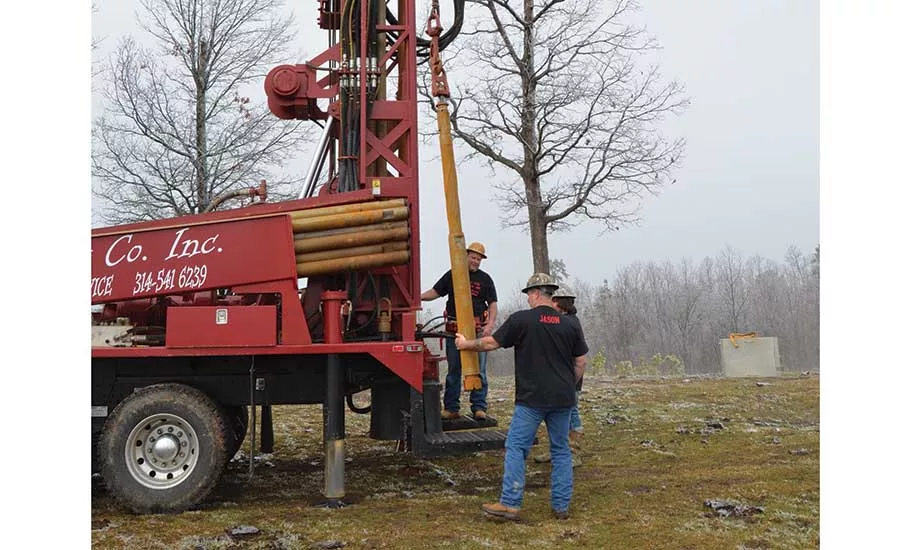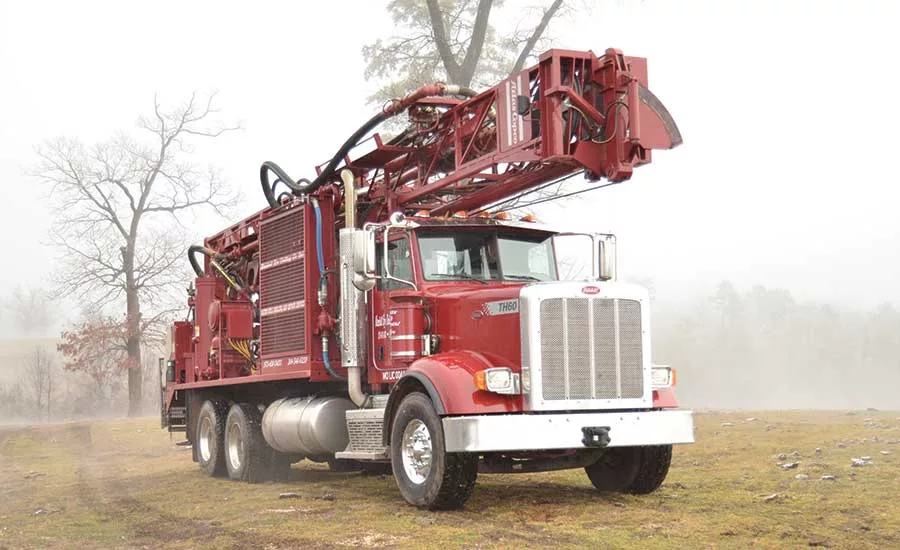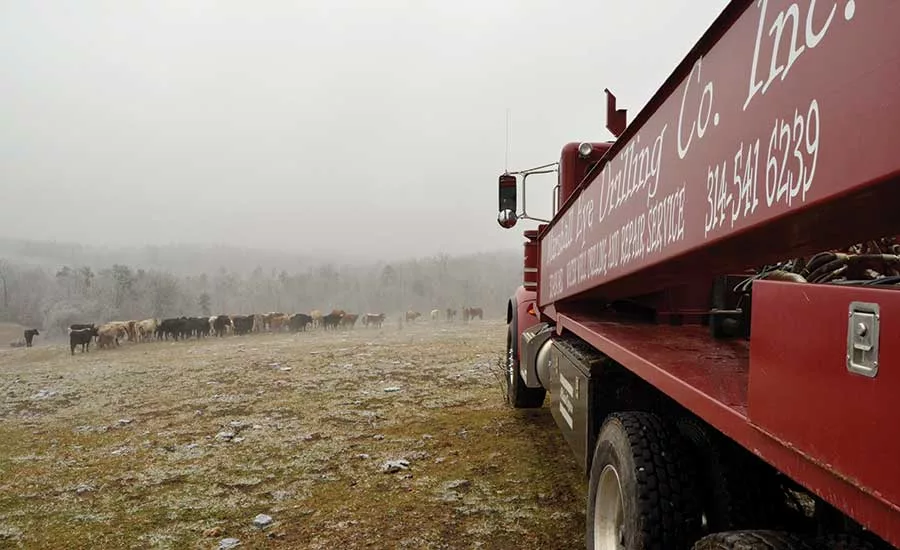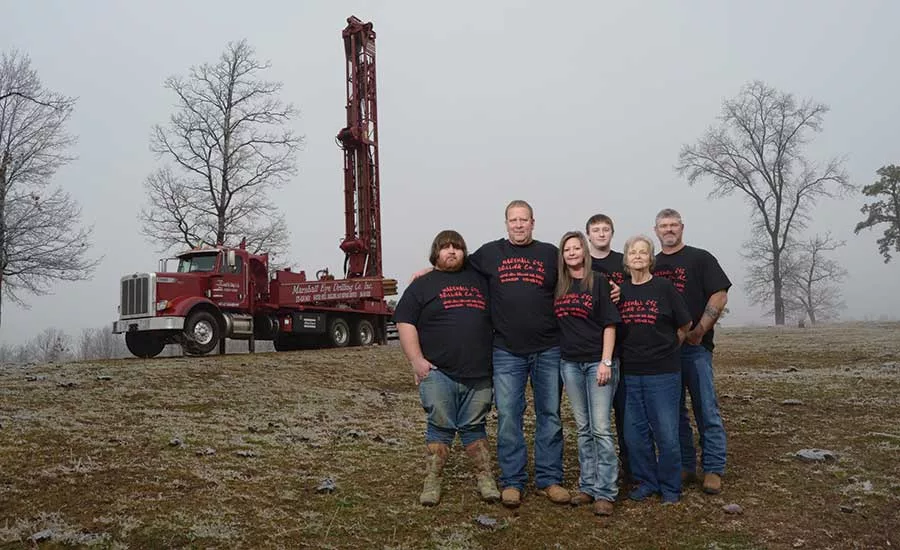Driller Turns Fire into Opportunity to Upgrade His Rig

Marshall Eye Jr. Drilling Co. Inc. has worked in the area of Potosi, Missouri, southwest of St. Louis since 1958.
Source: Epiroc photos


With their new TH60 and a 10-inch bit and hammer, the company installed a 6-inch well yielding 40 gpm to a total depth of 180 feet on this rural jobsite.
Source: Epiroc photos

It’s almost as if someone set out to make Marshall Eye Jr. Drilling Co. Inc. an example of the pitfalls of the water well drilling business. Only the most resilient survive.
Marshall Eye founded his drilling company in 1958 near Potosi, Missouri. He built it up using first a cable-tool rig, then a table-driven rotary rig and, finally, a high-pressure top-head air rotary. Marshall Eye Jr. Drilling became his area’s largest provider of well drilling, pump installation, well inspection and waterline repair services. At its peak, the company was completing up to 200 residential water wells a year — right up until the founder’s death in 2008.
The company’s doors stayed open. Marshall’s son, Felix, had returned home to help his aging father after working for drilling companies around the country. When he wasn’t lending his father a hand on particularly complex or difficult jobs, he was busy with his own independent pump service company. When his father passed on, his mother, Joann, stepped up as company president.
Then, market demand for water wells plummeted. It was during this time Felix began to fully appreciate just how much the company’s success was due to his mother’s dedication. “She worked harder than anyone since the very beginning, keeping track of the books and making ends meet. But in these hardest times, though, I really came to see how much we depended on her. When that wolf came howling at our door, Mom would just patiently wait for it to have pups and then sell them to keep the bills paid.”
With help from the company’s long-time employees, Joann was able to keep the company in the black. Then, a couple key employees left in 2017.
“Should we sell out, or do you want to try and keep it going?” she asked Felix.
Seeing it as an opportunity to make a fresh start, he leapt at the opportunity to run drilling operations. By now a seasoned driller himself, including a stint as an RD20 operator drilling gas and oil wells, he jumped right in, streamlining operations, cutting waste, trimming costs and widening margins. Demand for residential water wells was steadily coming back. On a drill site, he got to work alongside his wife, Crystal, and their oldest boy Taylor. It was a lifelong dream coming true for Felix — that is, until his father’s rig burst into flame beneath him one June afternoon.
From the Ashes
“All hell broke loose,” Felix says. “I had just grouted pipe in and was drilling my 6-inch hole. Our youngest boy, Trevor, who had been sitting in the passenger side of the drill truck cab, gestured to me. Did I want a bottle of water? I nodded. He left the cab to get one from the cooler on the pipe trailer. As he was approaching me on the operator platform, we all felt a ground-shaking explosion followed by a flash of fire from the entire underside of the rig. When I reached for the kill switch, a wall of fire burst over it like a fighter jet taking off.”
The fire sent everyone scattering in different directions, with Felix taking the most heat. “My whole backside from head to boots was hot as a wood stove full of pine knots.”
Felix dove across a nearby ditch, rolling on the ground to put the fire out. He learned there were no flames. His clothes were just so hot they felt like it. The fireball rose high over the crown of the mast. Two men working 100 yards away ran to get away from the intensity of its heat.
No one was hurt, Eye says. That was the main concern. “But the rig was toast and required extensive repair. We had several wells scheduled to drill yet, but nothing to drill with.”
After the fire, Felix found out that two other rigs, same make and model, had experienced almost the same fire-related incidents. “Safety was the number one reason I wanted to switch to a TH60,” he says.
Felix trusted the Epiroc brand’s entire rig line. Not only had he been an RD20 operator, he had tried to talk his father into buying a T3W years earlier. “My father was an obstinate man set in his ways. I was younger, more practical. Why work so much harder than you have to, was my way of thinking.”
Felix had also considered a T2W. It was the right size, and he was attracted to the dual-purpose engine design, yet the TH60 proved itself to be the perfect match.
He contacted Tyler Williams of Venture Drilling Supply for a used TH60 rig. But finding a used rig that could live up to Eye’s expectations proved too tall an order. “Felix keeps his equipment in such spectacular shape that what most people consider a high-value used rig just doesn’t impress him,” Williams says.
Eye decided a new rig would give him greater confidence in the acquisition, and he took delivery in August 2017. “Remarkably, every customer on the books waited patiently for our comeback,” he says, “and it’s been awesome ever since. Jason (Wright) hired on about three months later and seems to be one of those people like me that is love-sick for drilling.”
Back to Work
The company is located in Missouri’s Mark Twain National Forest. The base of operations lies at the edge of the Ozark Highlands 75 miles southwest of St. Louis. The groundwater resource here lies mostly in limestone beneath 1 to 16 feet of clay with layers of sandstone and shale. “My dad knew every formation in this area by name and to the inch,” Eye said, “from the Eminence Formation to where it jumps into the Potosi. Glacial activity here basically folded the Davis Shale back over itself. You’ll mostly drill through thin layers of shale until you hit limestone, though it can vary quite a bit from well to well.”
For working this location, Felix had two qualifications for his choice of rig, in addition to safety. The rig must be small enough to work on his customer’s residential properties without tearing them up. And it had to be robustly built, yet versatile enough, to work the varying formation.
Eye set up the TH60 recently on a residential well on a remote, rural property where curious cattle were still in the yard. He began with a 10-inch bit on a QL 80 DTH hammer, quickly punching through 16 feet of overburden containing thin bands of sandstone in clay. He continued to 80 feet in limestone and cased this upper section of the well profile with 6¼-inch PVC.
After casing was installed, he grouted using 14 bags of bentonite chips and continued to drill the production hole using a COP 64 hammer with a 6-inch concave face bit to a total depth of 180 feet yielding 40 gpm. Eye then air flushed the well as Taylor and Jason cleaned up the work area and gave the rig a quick wash down.
By the time they were ready to trip out and pack up, the well was producing near-perfect water with no sediment present. Although no stopwatch was used, it seemed like no longer than 20 minutes had passed until the brightly lit mast quietly descended. The crew packed up and was ready to travel back to the shop.
As Eye climbed into the cab, he smiled and said, “It’s days like this that make me thankful for going with my gut and owning this TH60.”
Looking for a reprint of this article?
From high-res PDFs to custom plaques, order your copy today!





